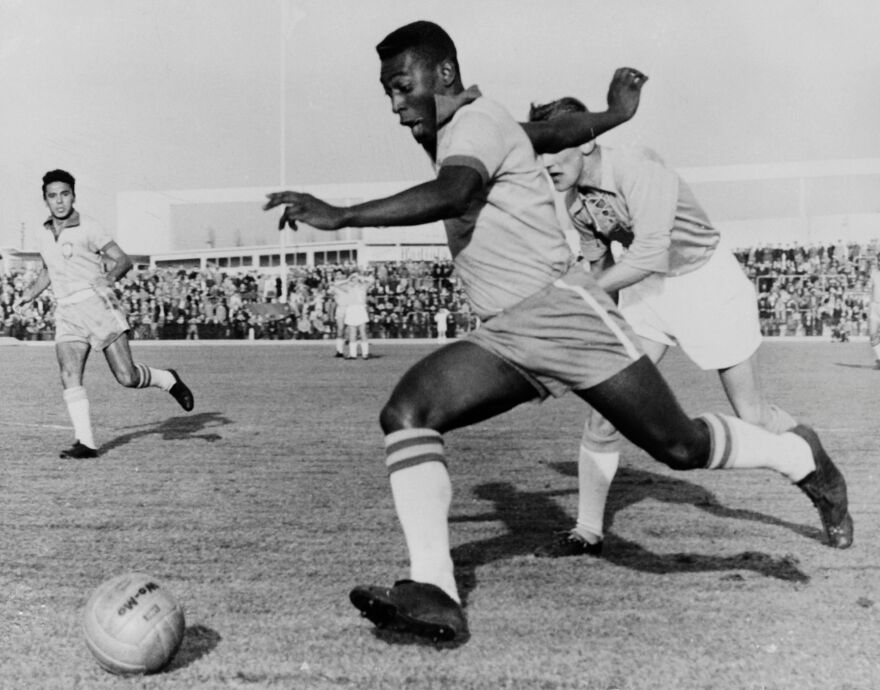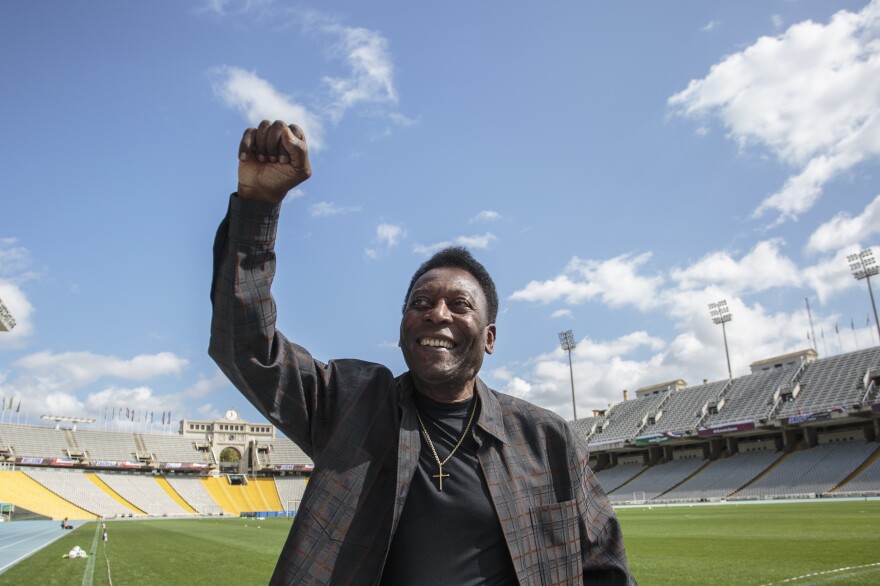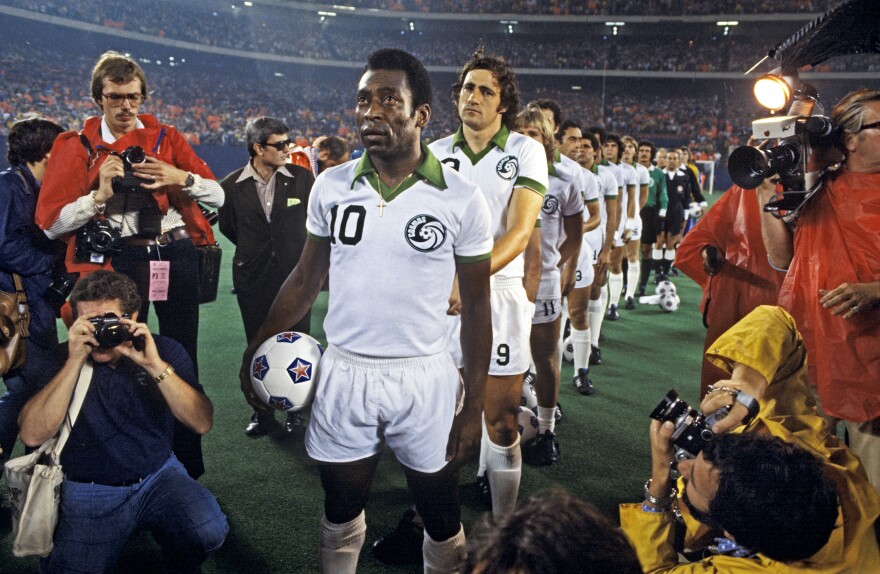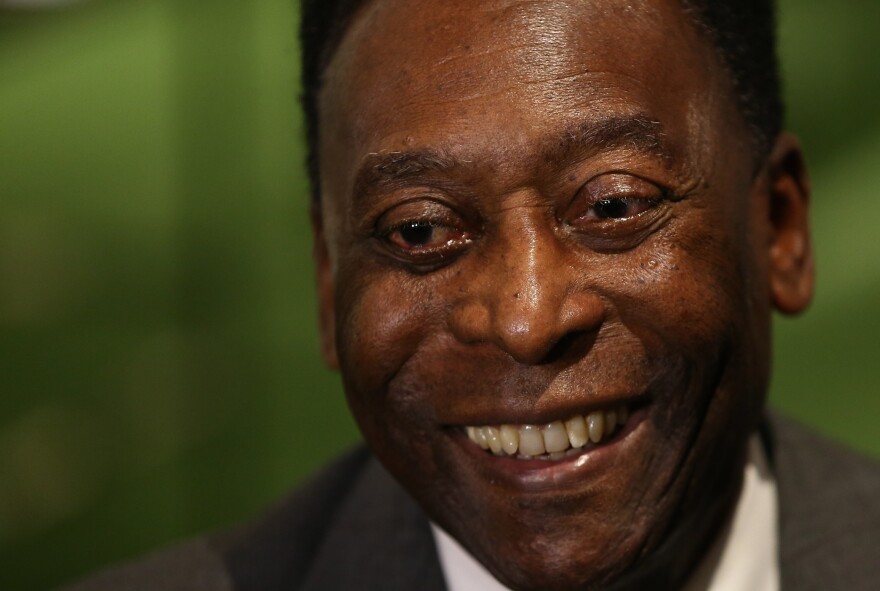RIO DE JANEIRO — The soccer star Edson Arantes do Nascimento — known around the world as Pelé — has died at 82. He'd been battling complications from colon cancer and had been admitted into a hospital in São Paulo last month.
One of his daughters, Kely Nascimento, announced his death on Instagram — showing a picture of his family's hands holding his hand. "Everything we are is thanks to you. We love you infinitely. Rest in peace."
Pelé was soccer's global face for decades and is regarded by many as its best player of all time. He rose from humble beginnings in rural Brazil to eternalize a powerful and creative style of play.
"He walks on the field with one of those irresistible and fatal authorities. I would say that of a king," penned Brazilian writer Nelson Rodrigues upon watching a 17-year-old Pelé play in 1958.
Pelé went on to reign over global soccer for the next 20 years, including a stint for the New York Cosmos, the only team outside Brazil for which he ever played.

Making soccer art
It was in 1958, during one of the first televised World Cups, that Pelé debuted to thrilled global audiences as a young striker.
In the tournament's final game against Sweden, he flicked the ball high over his defender's head and smashed it into the net. He then headed in another goal, cementing a victory (at 17, he remains the youngest player to score in a World Cup). At the time, Brazil's economy was booming, and the team's exuberance became a symbol of the country itself.
"The whole world cares about football, and the biggest footballer was Brazilian," says Brazilian sports commentator Marcelo Barreto. "I think we related to Pelé because of his creativity."

During a career including three World Cup titles — more than any other player in history — and over 1,200 goals, Pelé became known for his flair and unpredictability. He would blow past his opponents by dribbling the ball off their shins. He was also a playmaker and one of the early pioneers of the bicycle kick, a leap upward at an airborne ball to rocket it backward.
Barreto says that Pelé's athleticism could have easily earned him stardom in track and field as well as soccer. "He could run 100 meters in, like, 11 seconds. He could kick with the right foot and the left foot. It was like his strength was at the service of the beauty of the game."

A rise from humble roots
Pelé grew up watching his father play professionally in a small town in southeastern Brazil. He played in the streets, where he earned his nickname, and then in youth leagues. There, a former Brazilian national team player coached him and oversaw his move at age fifteen to the club Santos, near São Paulo.
At the gym at Santos, he added judo and karate to workouts. His teammate Mengálvio Figueiró said most players as talented as Pelé didn't worry so much about physical conditioning, but Pelé "ran to the front of the line to do laps around the field."
Pelé said in an interview to CNN that he tried to follow a lesson from his father: "If you be focused, if you have good health — nobody's gonna stop you."

As he began to rack up wins for Santos alongside a powerful attacking squad, Pelé's career also coincided with a golden age of Brazilian sportswriting, according to journalist Andrew Downie. The brothers Nelson Rodrigues and Mario Filho, known also for playwriting and political journalism, relished covering soccer matches, especially Pelé's, with "beautiful and acerbic wit," says Downie. "People would buy the newspaper to see what they were saying" and pack stadiums to see what would happen next.
One Pelé goal that blew past six defenders and inspired a near-two-minute standing ovation in Rio de Janeiro's Maracanã stadium moved a sportswriter not only to recount it in newsprint, but also to arrange for a commemorative plaque to be affixed to the sporting arena, birthing a Brazilian expression for any gorgeously executed feat: "plaque-worthy goal."
Pelé was named Athlete of the Century by the International Olympic Committee, Player of the Century by the International Federation of Football History and Statistics, and joint Player of the Century by FIFA. He is an honorary knight of the British Empire and served as a UNESCO Goodwill Ambassador and Brazil's Minister of Sports, where he oversaw new legislation on labor rights for athletes.

Symbolizing the world's game
Over the course of his life, Pelé was devoted to spreading the image of soccer's power to transcend national borders.
One of the most famous photos in sports history is of his embrace of English defender Bobby Moore at the 1970 World Cup. Santos attracted fans playing exhibition games across the world, and Pelé proudly recounted that world leaders like Nelson Mandela and Desmond Tutu were among his admirers. In the late 1970s, he played for the New York Cosmos, boosting American interest in the game. On the day Pelé retired, he reiterated his positive message to a packed stadium, asking fans to repeat the word "love" with him three times.
But even as he championed the idea of soccer as a unifier, Pele's life intertwined with racial and political divides at home. One of his biographers, Angelica Basthi, said after Brazil lost the 1950 World Cup with a Black goalkeeper, a racist narrative spread that Black soccer players were unreliable.
Until the 1958 victory, that is, when "people started to see Black players through the talent of Pelé."
Even so, Black Brazilian civil rights leaders would later criticize Pelé for ignoring their calls to denounce racism in the country, Basthi said: "He bet on an earlier narrative" that his success disproved there were racial barriers. Pelé faced criticism for other actions of his off the field, including a fierce battle against legally recognizing one of his daughters.
He often responded to critiques by saying that Pelé, the player, was separate from Edson, the man, who was flawed.
Marcelo Barreto says that today, Brazilians are starting to judge athletes more for the political implications of their actions. "We are slowly beginning to understand that it's not only soccer. That soccer is not separated from our society, from our life."

In terms of athleticism, Barreto says, Pelé continues for many Brazilians to represent the country's capacity for greatness.
As the pace, geography, and gender of the world's best soccer has shifted since Pelé's heyday, it continues to entrance billions.
Pelé accompanied the careers of young Brazilian and international players until the end of his life. In 2011 he said, "I think it will be, always, the beautiful game."
Copyright 2023 NPR. To see more, visit https://www.npr.org.



